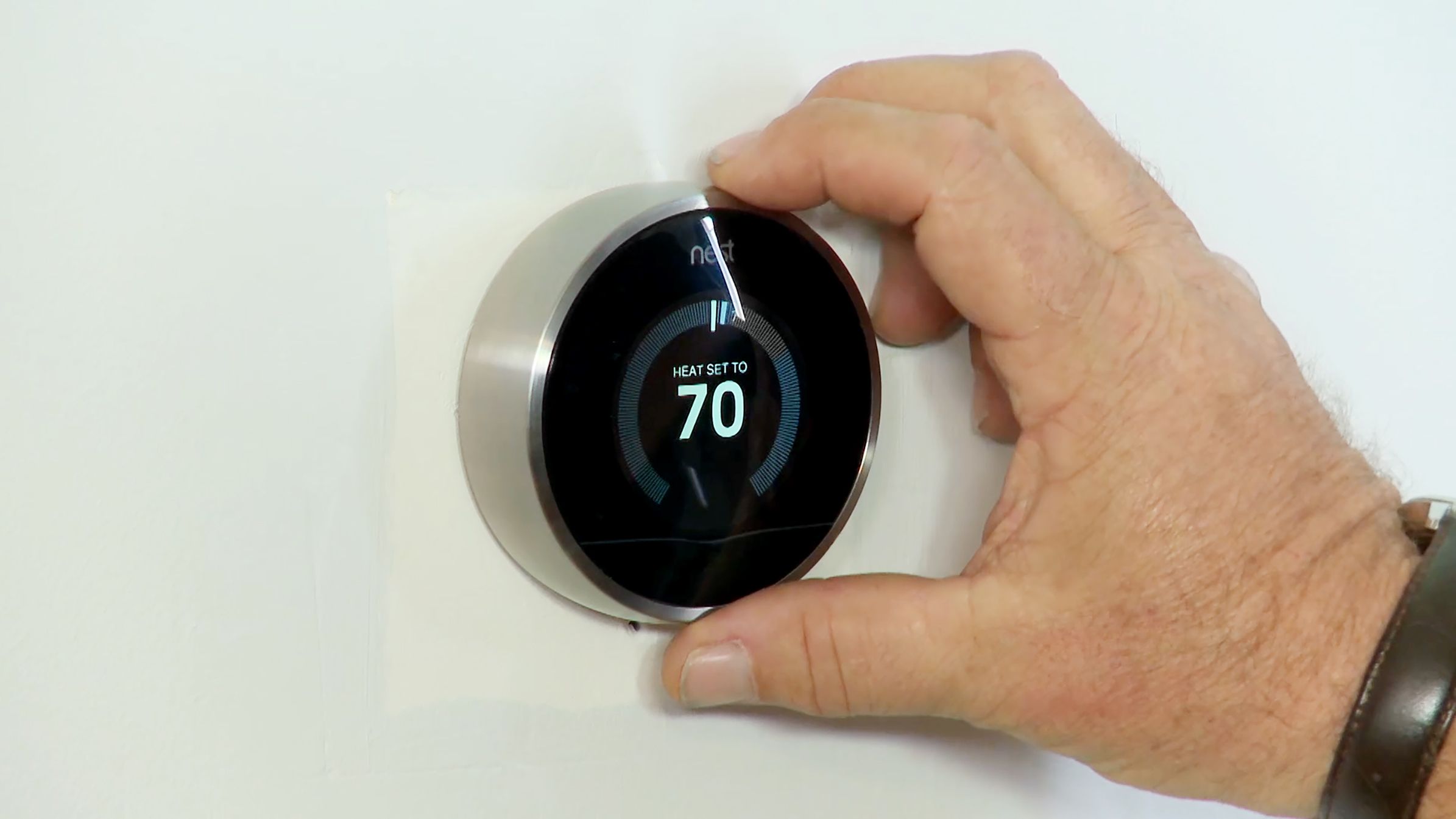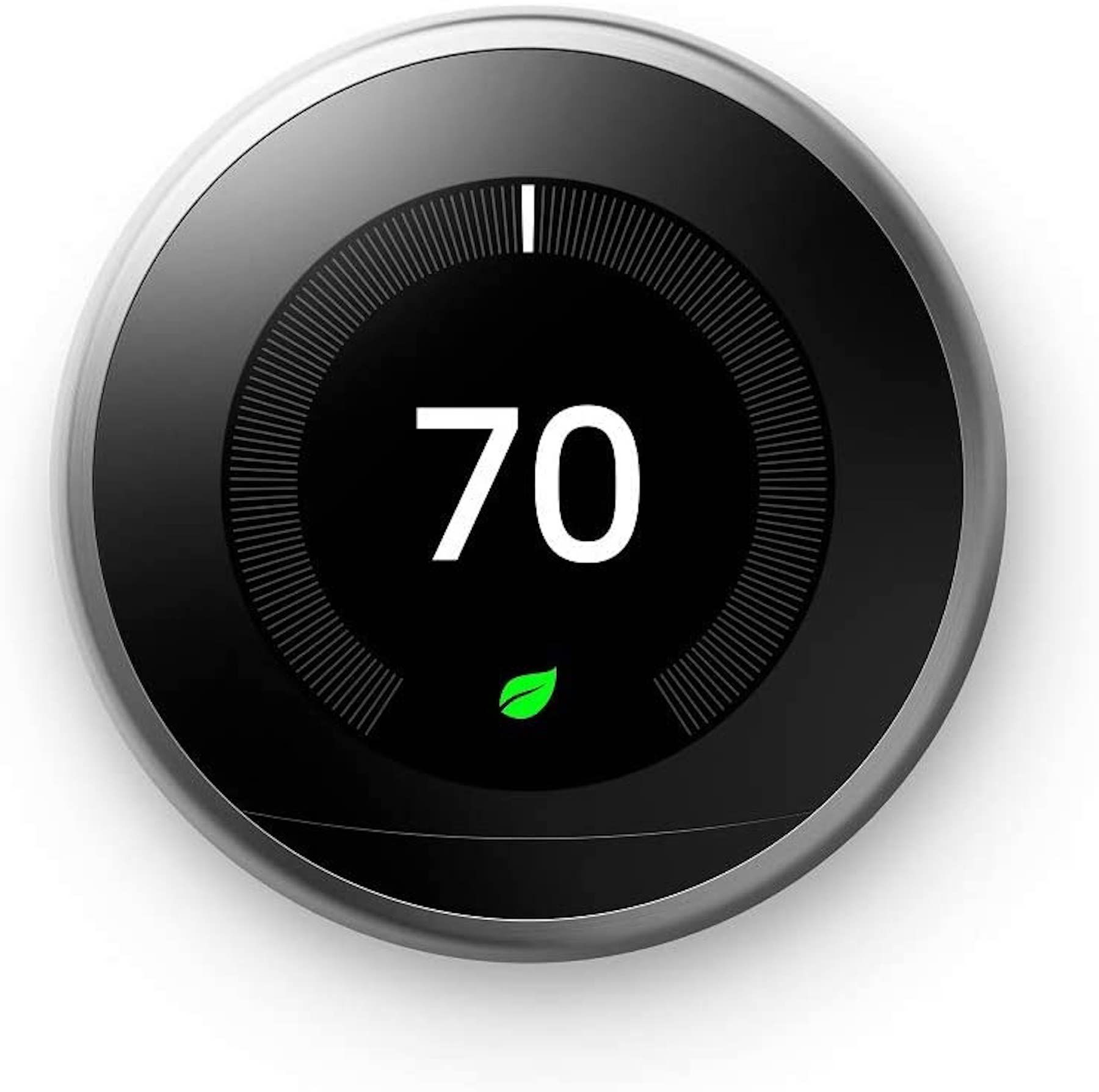We may be compensated if you purchase through links on our website. Our team is committed to delivering honest, objective, and independent reviews on home products and services.
Smart thermostats are revolutionizing home heating and cooling systems, offering homeowners a blend of convenience, energy efficiency, and cost savings. These innovative devices learn your habits, adapt to your schedule, and can be controlled remotely. While they require a higher initial investment and some technical setup, there are many long-term benefits to these systems for homeowners. In this comprehensive guide, we’ll dive into how smart thermostats work, their key features, installation requirements, and how to get the most out of your smart thermostat and reduce your energy bills.
What is a Smart Thermostat?
A smart thermostat is a Wi-Fi-enabled device that automatically adjusts your home’s heating and cooling temperature settings. They hardwire into your home’s internet network, letting you control your HVAC system remotely through a smartphone app or web interface. Smart thermostats can learn from your behaviors, allow you to control the climate in your home using a smartphone, and show you energy consumption in real-time.
How They Differ from Traditional Thermostats
Traditional thermostats range from simple dial-controlled devices to programmable models with basic scheduling capabilities. In contrast, smart thermostats offer a host of advanced features:
- Integration with smart home systems: Can be synced with other smart devices in your home.
- Learning capabilities: They can learn your preferences and routines to adjust settings automatically.
- Remote access: Control your home’s temperature on the go using a mobile app.
- Energy usage reports: Provide detailed info on your energy usage.
Key Features of Smart Thermostats
Smart thermostats offer features designed to improve comfort, convenience, and energy efficiency. Let’s take a closer look at some of these devices’ most useful features.
Learn and Adapt to Your Schedule
Smart thermostats can learn your schedule and adjust accordingly. After a period of manual adjustments or input from you, the thermostat begins to understand your preferences, and then automatically adjusts the temperature when you’re at work, asleep, or about to return home.
Remote Control via Mobile Apps
Smart thermostats connect to mobile apps so you can control your home’s temperature from anywhere with an internet connection. This feature is handy if you’re coming home early and want to adjust the temperature before you arrive or if you forgot to adjust the settings before leaving for vacation. It can also set reminders for scheduling maintenance and replacing air filters.
Energy Usage Tracking and Reporting
Many smart thermostats provide detailed energy usage reports, helping you understand your consumption patterns and make informed decisions about your energy use. Some models can even detect if there’s a problem with your HVAC unit so you can address small issues before they become major problems.
Integration with Smart Home Systems
Smart thermostats often integrate easily with other smart home devices for a more convenient, comprehensive smart home system. For example, you can connect them to smart speakers to control your home’s temperature with voice commands.
Our Smart Thermostat Recommendation
How Smart Thermostats Work
Let’s explore the key inner workings of smart thermostats and how they function.
Wi-Fi Connectivity
Wi-Fi connectivity allows the device to communicate with your smartphone, receive software updates, and access weather forecasts. While Wi-Fi is necessary for remote operation and advanced features, if your Wi-Fi goes out, you can still manually operate a smart thermostat just as you would a regular one.
Sensors and Data Collection
Smart thermostats have various sensors that collect data about your home environment, which the thermostat uses to make smart decisions about your air conditioning. These sensors include:
- Temperature sensors
- Humidity sensors
- Occupancy sensors
- Light sensors
Algorithmic Decision Making
Smart thermostats use complex formulas to process the data collected from their sensors and your usage patterns and make decisions about when to adjust the temperature, change energy usage, and maintain comfort levels.
Requirements for Smart Thermostat Installation
Make sure your home construction is suitable for a smart thermostat. Here are some factors to keep in mind before you move forward with your installation.
Compatibility with Your HVAC System
Not all smart thermostats are compatible with every HVAC system. Check with your manufacturer to make sure your desired smart thermostat will work with your heating and cooling setup. This is especially important if you have an older home or a unique HVAC configuration. Many smart thermostat manufacturers offer compatibility checkers on their websites to help you determine if their products will work in your home.
Wi-Fi Network Availability
A smart thermostat needs a stable, reliable Wi-Fi connection to function. Make sure you have good Wi-Fi coverage in the area where you plan to install the thermostat. If your Wi-Fi signal is weak in that location, buy a Wi-Fi extender or move your router.
Power Source Considerations
Most smart thermostats require a constant power source, typically provided by a C-wire (common wire) in your HVAC system. Not all homes have a C-wire installed, especially those with older HVAC systems. If your home lacks a C-wire, you may need to have a professional install one or choose a smart thermostat model that can work without one.
Step-by-Step Installation Guide
Many homeowners can easily install a smart home thermostat system themselves. However, if you’re uncomfortable working with electrical wiring, hiring a professional is best. Here’s a general guide to installing a smart thermostat:
Step 1: Turn Off Power to Your HVAC System
Turn off the power to your HVAC system at the circuit breaker and furnace power, if applicable. This safety measure will protect you and prevent electrical fires.
Step 2: Remove the Old Thermostat
Remove the faceplate of your old thermostat. Before you disconnect the wires, take a photo of the current connections for reference.
Step 3: Wire the New Smart Thermostat
Remove the old thermostat’s backplate and install the new smart thermostat. Connect the wires to the corresponding terminals on the new thermostat, using your photo as a guide. Most smart thermostats come with clear labeling and instructions for wire connections.
Step 4: Mount and Power Up
Click the thermostat into the base. Turn the power back on to your HVAC system and furnace.
Step 5: Initial Setup and Programming
Follow the on-screen instructions to connect your thermostat to your home’s Wi-Fi network. To complete the setup, you’ll likely need to download the manufacturer’s app. The app will guide you through initial programming, including setting your preferred temperatures and schedule.
Drawbacks of Smart Thermostats
Smart thermostats may not be appropriate for every home setup, so research them thoroughly to make sure they’re compatible with your current system.
Initial Cost Considerations
While certainly more expensive than a traditional thermostat, smart versions don’t cost as much as they used to. Depending on the features you want, you can expect to pay around $140-$300. Some versions even cost as little as $80. Energy savings can offset this initial investment over time, so factor this in as well. Professional installation can add $50 to $150 per hour to the price.
Figures sourced from HomeAdvisor.
Privacy Concerns
Smart thermostats collect data about your home and habits, which may bother some homeowners. Review the manufacturer’s privacy policy to better understand how your data will be used and protected.
Dependency on Internet
While smart thermostats can operate manually without an internet connection, many of their advanced features need Wi-Fi. If your internet connection is unstable or goes down frequently, you won’t be able to take full advantage of your system.
Energy and Cost Savings with Your Smart Thermostat
Read below for tips on how to make your smart thermostat as energy-efficient as possible.
Set Optimal Temperature Schedules
Set energy-efficient temperatures for when you’re asleep or away from home. Many smart thermostats can learn your preferences over time, but you can manually schedule the adjustments as well.
Geofencing Features
Geofencing uses your smartphone’s location to determine when you’re leaving or returning home. This feature can automatically adjust your home’s temperature based on how close to home you are, providing comfort when you arrive and energy savings when you leave.
Regular Maintenance and Updates
Clean your device regularly, replace the batteries as needed, and stay on top of the latest software updates. Many smart thermostats can remind you when it’s time to change your HVAC system’s air filter which also contributes to your unit’s energy efficiency.


